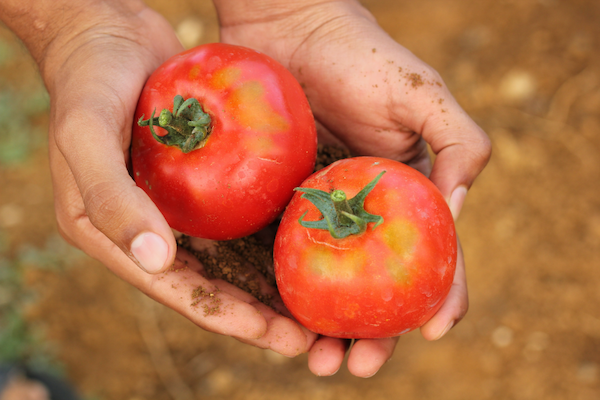 Plant Biology
Plant Biology
A future of tasty tomatoes
Modern tomatoes are very different from the original tomatoes from South America. Breeding has caused the loss of many essential genes, including those for flavor. Inserting these genes back into modern tomatoes will allow tomatoes to regain flavor.

Modern tomatoes have weaker flavor than older heirloom varieties, and consumers often complain about their "tastelessness". But, how did these tasteless tomatoes arise? - one cause is breeding. Tomatoes have been continuously bred to improve their agricultural features. While these features mostly include firmness for shipping, shelf-life, and disease resistance, the flavor has been often ignored. Consequently, modern tomatoes have increasingly poorer flavor. The selection of good flavor is not simple because the flavor is a complex feature that comes from a unique combination of sugars, acids, and a variety of aroma compounds. This is why breeding for flavor is complicated, expensive, and unfortunately, current breeding methods are suboptimal.
Tomatoes have a unique and exciting history. They were first domesticated in Peru, where they originate from, and then they were spread throughout northern South and Central America. Spanish explorers to the Americas first introduced tomatoes to Europe in the 16th century. These European varieties were then carried back to North America by English colonists. Since only a small variety of the first tomatoes native to Peru were transported to Europe, where the diversity among them was further reduced with selective breeding, this reduction occurred again in the migration back to North America. What makes modern tomatoes different from the original tomatoes? - It is a genome, which is an entire set of genes. Each gene makes a unique protein. Proteins are the functional machinery of life. Notably, the proteins involved in metabolism can change the flavor of tomatoes. In other words, the flavor can be altered when the genes for the proteins that are important in the flavor metabolism are lost or broken. Therefore, finding the flavor genes that were lost during these migrations may allow us to develop a way to insert the flavor back into modern tomatoes.
Recently invented techniques to sequence the entire genome of an organism at a low cost has revolutionized biology. Now the entire DNA sequence of different varieties of the same species can be compared. Here, by examining the genetic sequences of 725 tomato varieties, including early, heirloom, modern tomatoes, we have identified 4873 genes that are not present in modern tomatoes. These genes were lost during both domestication and improvement of tomato cultivars. Some were lost since tomatoes were domesticated and spread from Peru to northern South America. More were lost while tomatoes spread to other parts of the world. The lost genes were related to diverse functions in the tomato plant and fruit, but especially plant defense responses and disease resistance. For instance, a gene important for plant defense against a particular disease was lost during domestication, resulting in a loss of disease resistance in heirloom tomatoes. Notably, the lost genes included some genes that appear to be essential for the production of aroma compounds.
An interesting gene we found is LoxC (lipoxygenase C), which is known as involved in lipid metabolism. We discovered that modern tomatoes rarely have a particular sequence in that gene, which is found in the most of early tomatoes. Importantly, this characteristic sequence that was lost during domestication leads to a higher production of several important flavor compounds. Therefore, inserting this sequence back into modern tomatoes would serve an efficient way of improving the flavor.
Further research will be to find more genes related to flavor in the lost gene sequences. Return of the lost characteristics to modern tomato could improve many important features, including flavor, disease resistance, shelf-life, and stress tolerance. The genetic information would serve an important resource for efficient breeding in the future.
Original Article:
Gao L, Gonda I, Sun H et al. The tomato pan-genome uncovers new genes and a rare allele regulating fruit flavor. Nat Genet. 2019;51(6):1044-1051.Next read: How to fight climate change? Let forests grow by Susan C. Cook-Patton , Sara M. Leavitt , Peter W. Ellis
Edited by:
Dr. Akira Ohkubo , Associate Editor
We thought you might like
Mapping industrial and agricultural ammonia hotspots
Sep 4, 2019 in Earth & Space | 3 min read by Martin Van Damme , Lieven ClarisseDoes eating vegetables reduce cardiovascular risk? It’s not so simple
Apr 21, 2023 in Health & Physiology | 3 min read by Qi FengWhen gut bacteria spoil drug treatment
Sep 18, 2019 in Microbiology | 3.5 min read by Michael Zimmermann , Maria Zimmermann-Kogadeeva , Andrew L. GoodmanDid Homo naledi meet Homo sapiens in South Africa?
Feb 8, 2018 in Evolution & Behaviour | 4 min read by Hannah Hilbert-Wolf , Paul Dirks , Eric RobertsMore from Plant Biology
Unravelling the Secrets of Pine Roots: A Tale of Nutrition and Adaptation
Oct 20, 2023 in Plant Biology | 3.5 min read by Rafael Cañas , Francisco OrtigosaStressful memories help plants resist caterpillars
Oct 2, 2023 in Plant Biology | 3.5 min read by Samuel Wilkinson , Adam Hannan Parker , Jurriaan TonDecoding the genome of a jackfruit that grows all year round
Sep 6, 2023 in Plant Biology | 3.5 min read by Tofazzal IslamLife after logging: the tale of recovering tropical forests
Aug 21, 2023 in Plant Biology | 3.5 min read by Maria Mills , Terhi RiuttaEditor's picks
Trending now
Popular topics


